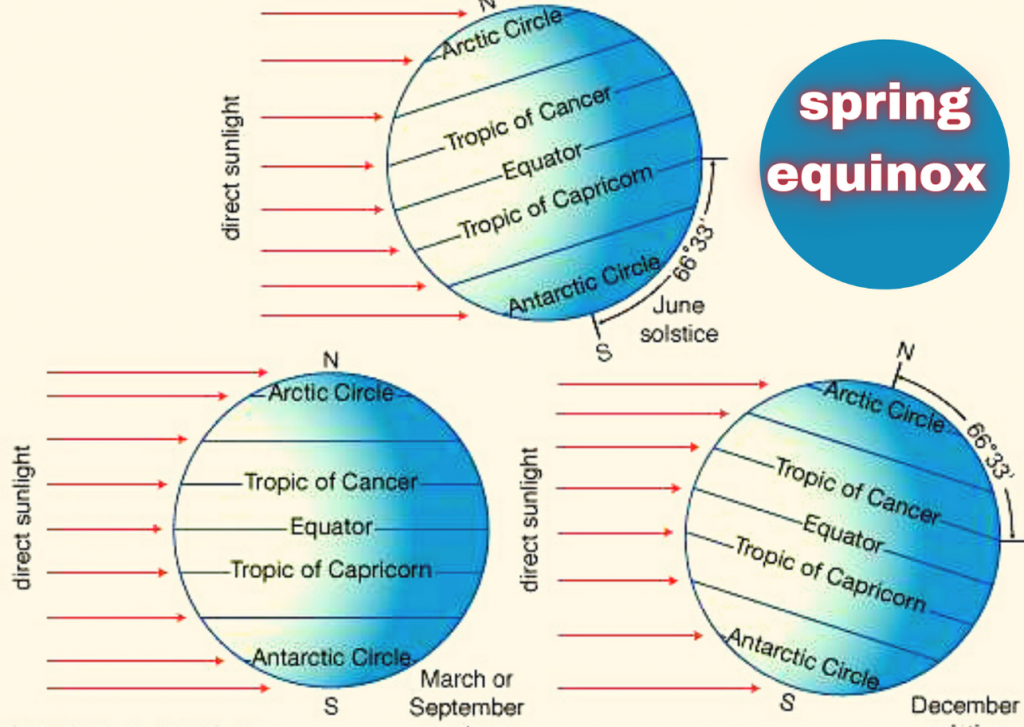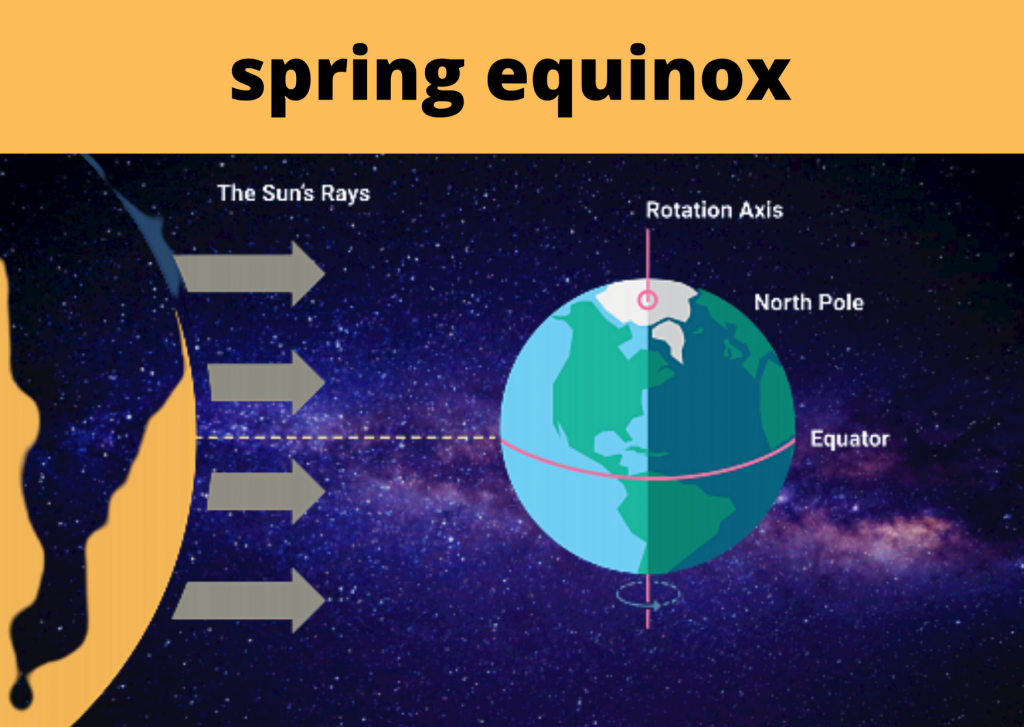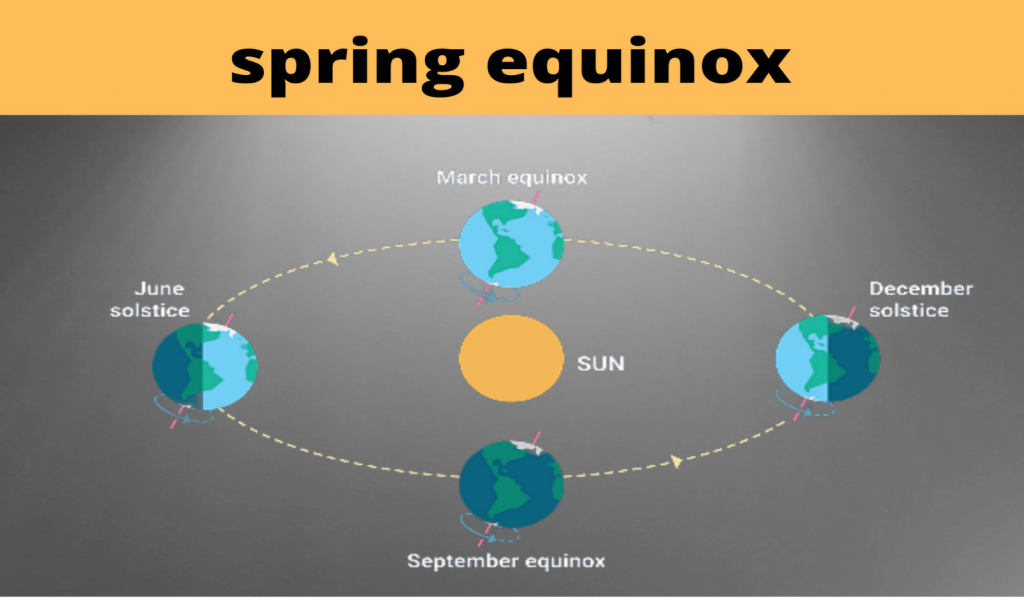Equinox Definition
The vernal equinox, twice a year when the Sun is above the Equator and day and night are equal in length; and, any two points in the sky where the ecliptic (the path of the Sun of the year) and the celestial equator meet. In the Northern Hemisphere, the local equinox falls about March 20 or 21, as the Sun moves across the celestial equator to the north. In the Southern Hemisphere, the equinox occurs on September 22 or 23, when the Sun moves south across the celestial equator. According to the constellations of the seasons, the vernal equinox also marks the beginning of spring, which lasts until the summer solstice (June 20 or 21 in the Northern Hemisphere, December 21 or 22 in the Western Hemisphere).
Equinox Explanation:
The Earth’s axis is tilted at an angle of about 23.4 ° toward the ecliptic plane, a symbolic plane formed by the Earth’s orbit around the Sun. On any other day of the year, either the Southern Hemisphere or the Northern Hemisphere slightly tilted toward the Sun. In the case of two equinoxes, the slope of the Earth’s axis corresponds to the rays of the Sun, as shown by the figure.
Dates of Equinoxes:
In the Northern Hemisphere, spring, or vernal equinox, occurred about March 21, when the sun moves north across the celestial equator. The autumn equinox took place about September 22, when the sun crossed the equator to the south. But if you want to be truly balanced, choose to say March equinox and September equinox instead. After all, in the south of the country, March represents the beginning of autumn and spring coming in September!
The equinox has promoted many interesting myths, including that the event causes a major disruption of communication satellites, or that in the equinox the egg can be easily measured at its end (egg measurement is a skill you can do any day of the year).

Equinoxes in Different Countries
The question of which definition to use divides countries and regions around the world. For example, Australia and New Zealand use a weather forecast, so spring starts on September 1 each year. In many other countries, both definitions are used, depending on the context.
In Ireland, St. Brigid’s Day on February 1 is often thought to mark the beginning of spring in the ancient Celtic calendar system. Some cultures, especially those in South Asia with calendars that divide the year into six periods, instead of the four most familiar.
In Finland and Sweden, the dates of the seasons are not based on the calendar at all, but at temperatures. This means that the seasons in each region begin and end on different days, depending on the region and its climate. In Iceland, the first day of summer, a national holiday, is the first Thursday after April 18th.

Facts About Equinox
On Saturday, March 20, 2021, day and night will be approximately the same length in many time zones around the world. Here are 10 facts about the March Equinox that you may not be aware of.
1 Also the Autumnal Equinox
The March equinox is the vernal (spring) equinox in the Northern Hemisphere and the autumnal (fall) equinox in the Southern Hemisphere.
2 The first Equinox of the year
The second equinox, the September equinox, occurs on September 22 or almost every year. It is the spring equator of the Southern Equinox and the equinox of the fall of the Northern Hemisphere.
3 Mark the First Day of Spring
In the Northern Hemisphere, astronomers and scientists use the March equinox as the start of the spring solstice, which ends in the June solstice, when the summer solstice begins. On the other hand, meteorologists in the spring of the Northern Hemisphere begin three weeks before the March equinox on March 1 and end on May 31.
4 Time Period
Many cultures around the world celebrate the day as a March equinox. In reality, however, the equinox occurs at some point when the Sun crosses the celestial equator, an imaginary line in the sky above the Earth Equator, from south to north. At the moment, the Earth’s axis is not tilted away from or near the Sun, but is facing the rays of the Sun, as shown in the picture. In 2021, this is March 20, at 09:37 UTC. With areas 10 hours or more behind UTC, it will be lonely on March 19. This is due to the time zone difference.
5 Date of Equinox Can Vary
Do you remember where the Spring Equinox was celebrated on March 21? Well, remember again, because the last thing happened in 2007 and the future will happen in 2101! Contrary to popular opinion, March Equinox could happen on March 19, 20 or 21. In the 21st century, the March Equinox only happened twice on March 21 – 2003 and 2007. for a hundred years.
Note: These dates are based on the equinox period in UTC. Due to time zone variations, places before UTC can celebrate March Equinox the next day, and places after UTC can celebrate the day before.
6 Equal day and night
Common sense suggests that in the equinox everyone in the world gets to experience the same day and night of the same length – 12 hours a day and 12 hours of night time. In fact, the word equinox is derived from the Latin aequus, meaning equilibrium, nox, meaning night.
7 Atmosphere reflects
In fact, most places on Earth see more daylight than equinoxes at night. This is because of two reasons: how the sun rises and sets and how the atmosphere reflects the sun’s rays. Most parts of the world, with the exception of Equator, have about the same day and night about twice a year. The dates of this event, also known as the equinox, depend on the local distance and can be a few days before or after the equinox.
8 Not Only The Day Of The Egg Measure At The End Of It
Every year at the Spring Equinox, we hear that it is the only day of the year when the egg can be fully measured at its end. Many try and those who fail are told not to try at the exact time of the equinox. The truth is, though, that there is nothing magical about the equinox or the time it takes place – you can completely measure an egg at its end on any given day.
9 One of the two days of this test
To perform this test, you will need a straight stick or long wooden ruler, protractor and compass. Find an empty space such as a park or a parking lot where there are a few tall buildings, trees or hills to block out the Sun. Find the width of your area. Subtract this number from 90. This will be the angle at which you will attach the stick to the ground. If you are in the Northern Hemisphere, use your compass to find the south and point the stick at that point. If you are in the Southern Hemisphere, point to a stick or ruler in the north. Using a protractor, adjust the rod to the ground at right angles – remember to point it in the opposite direction.
10 Celebrated Worldwide
Many cultures around the world make deals and celebrate festivals and holidays to mark the March Equinox.
Differences between Equinox and Solstice
In addition to the two annual equinoxes, there are two solstices annually. The summer solstice, on June 20 or June 21 in the Northern Hemisphere, occurs when the sun is far away in the northern hemisphere; the longest day of the year in daylight.
The winter solstice, December 21 or December 22 in the Northern Hemisphere, occurs when the sun is very far south of the equator; the shortest day of the year. The word solstice comes from the Latin word “solstice,” meaning “suspended sun.”
